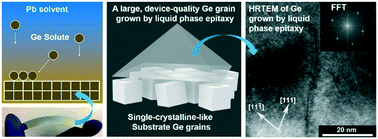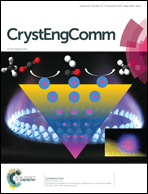Defect reduction by liquid phase epitaxy of germanium on single-crystalline-like germanium templates on flexible, low-cost metal substrates†
Abstract
Single-crystalline-like germanium (Ge) templates were demonstrated on low-cost, flexible metal substrates and have been used to fabricate III–V materials and devices for photovoltaics and flexible electronics applications. However, these Ge templates, fabricated by magnetron sputtering or plasma enhanced chemical vapor deposition, contain a high density of defects. In order to improve the performance of optoelectronic devices made using the Ge templates, a homo-epitaxial Ge layer has been additionally grown by a liquid phase epitaxy (LPE) method. The LPE Ge layer is composed of significantly larger grains (∼26 μm) compared to that of the Ge template (∼200 nm). This large size of the LPE Ge grains effectively reduces the volume fraction of grain boundaries. The LPE Ge shows an out-of-plane texture Δω of ∼0.63° and an in-plane texture Δϕ of ∼1.26°, which signify improvements of ∼39.3% and ∼76.6% compared to that of the vapor-deposited Ge template, respectively. Further, the LPE Ge is strain free, compared to the strained Ge template hetero-epitaxially grown on cerium oxide. Defects caused by low-angle grain boundaries, impurities and strain relaxation in the Ge template are found to be suppressed in the LPE Ge. The threading dislocation density is roughly estimated to be ∼5 × 106 cm−2 in the LPE Ge compared to ∼1 × 1010 cm−2 in the Ge template.



 Please wait while we load your content...
Please wait while we load your content...